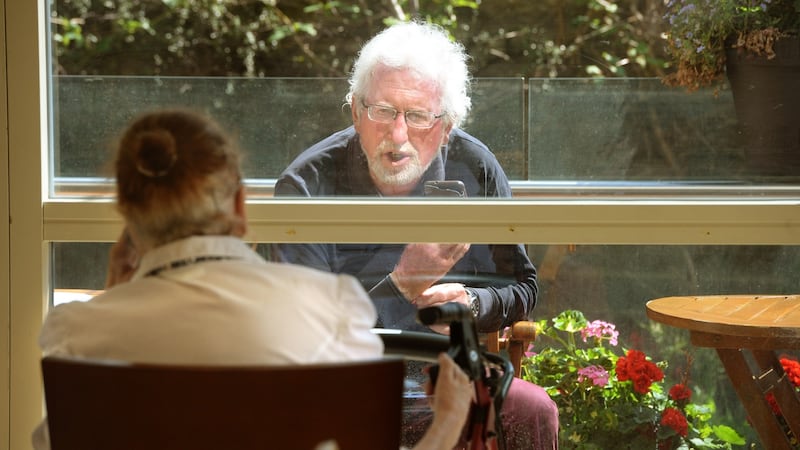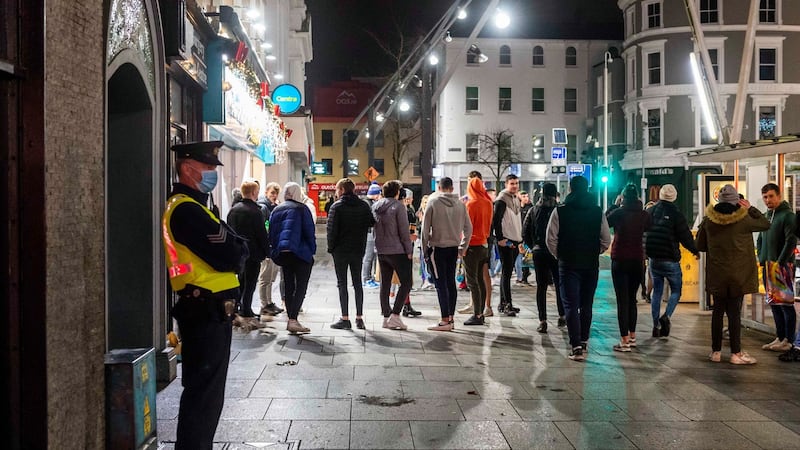On January 26th last year as China rushed to build a new hospital for coronavirus patients in the locked-down city of Wuhan, Health Service Executive chief executive Paul Reid called his national crisis management team together.
That Sunday, he convened a meeting for the next day to role-play scenarios for how the health system might cope if the respiratory virus that was killing people in China and spreading to other countries reached Irish shores.
“We got a sense that if the health system here gets hit with the pandemic, our capacity to cope would be severely challenged. It was a sense that something was brewing,” he says of that critical moment.
Within weeks, he was briefing government on plans to strengthen the health system with thousands more beds and to prepare for the arrival of Covid-19. At the end of one of those first briefings, two men approached him.
"Mark Mellett, chief of staff of the Defence Forces, came over and said, 'All our services are at the health system's disposal – you call it.' Drew Harris, the Commissioner of the Garda Síochána, then came over and said, 'I am going to graduate all the guards in Templemore [Garda training college] and you can have Templemore'," says Reid.
The State moved to an emergency footing to prepare for the worst public health crisis in a century in what Reid recalls was “an awakening of the value of the public service”.
UCD’s National Virus Reference Laboratory began testing for suspected Covid-19 cases on February 7th.

On February 29th, the lab's director, Cillian de Gascun, was having lunch with a friend when a colleague called: the lab had detected the first Irish case of Covid-19 in a Dublin teenager who had become ill on his return from Italy. De Gascun was relieved that the lab's testing was working, as Ireland was one of the last countries to detect a case.
“You are always concerned that it might not be working for some reason. There was a definite sense of relief in many respects that we had a case,” he says.
Within a fortnight, de Gascun, a member of the National Public Health Emergency Team (Nphet), was sitting in the Department of Health on Baggot Street in Dublin city centre alongside the State's chief medical officer, Dr Tony Holohan, after seeing test results showing a three-fold increase in cases in a single day.
The Nphet meeting on Wednesday, March 11th, went on for several hours, well past midnight, as the health crisis advisers knew that more severe action was required: a lockdown was needed. “We never had to do anything like that before. It was the introduction of restrictions when the true enormity of it hit me and made me realise, we are not in Kansas anymore,” says de Gascun.
Three lockdowns and three waves of disease later, the Covid-19 pandemic has changed Irish society beyond recognition. One year on from that first detected case, the daily count has left us with a toll of more than 4,000 deaths and more than 200,000 known infections in the Republic.
The one-year anniversary of Covid-19 in Ireland comes at arguably the darkest time in the pandemic, as the most severe wave of disease and death has coincided with the longest and most difficult lockdown. The past two months have been the worst of the crisis as infections surged following the Government’s “meaningful Christmas” plan.
The reopening of hospitality in early December and then household mixing over Christmas, combined with a more infectious UK variant, led to a surge in severe illness and deaths.
The death toll reached 2,000 in eight months but has more than doubled again in the past three. It took 10 months to reach 100,000 cases through the March-April and October-November waves but then doubled to 200,000 in just one month through the third wave in December and January.
Although it is little consolation to people who lost loved ones, the State’s fatality rate from the disease is in the bottom third across Europe, so the country has fared better than most others.

“We haven’t done as bad as other European countries. I don’t see what else they could have done,” says Prof Luke O’Neill, immunologist at Trinity College Dublin, of the State’s response. “We are not a police state; we can’t be like China. I am a tiny bit forgiving of what has been happening. I don’t think we are doing too badly.”
Early mistakes
The early mistakes are, however, clear to many observers looking back, one year on: the failure to stop flights from Italy, Europe’s Covid-19 hotspot; or travel to the Cheltenham racing festival; the months-long delay in advising people to wear masks; the slow rollout of testing; and the inadequate supply of personal protective equipment.
“A lot of that was battlefield decisions. It was a mess back then,” says Tomás Ryan, associate professor at the School of Biochemistry and Immunology at Trinity College Dublin.
The surge in Covid-19 cases expected in the hospitals in the first wave hit the nursing homes and care facilities instead. They have borne the brunt of the fatalities during the pandemic.
Public health expert Dr Gabriel Scally recalls a conversation with a contact tracer calling a Covid-positive foreign healthcare worker. The individual lived with eight others, all of whom worked in the care sector, in five different nursing homes, with some working in more than one.
“If that could happen and be tolerated, I knew it was going to be really bad. The failure to protect the most vulnerable in care homes will stand out in the history of this pandemic,” he says.
Reid acknowledges that the “one big learning” from the past year is that congregated settings are “highly exposed” in a pandemic and “not the way to protect people”.
“We all have to put up our hands and say, in the first phase, what could have been done differently, what could have been our earlier responses? That has been a learning for us. It is not an easy solution because it does transmit very quickly when it gets in,” he says.
De Gascun believes the structures and work practices within the care sector limited the range of responses and that one single intervention might not have been enough, given the challenges with staffing, the availability of personal protective equipment and testing capacity early on.
“We should have done better, but at the same time when you try and address that, it is very difficult to figure out what. When you have so much virus in the community, it is impossible to hermetically seal residential care facilities off,” he says.
Travel
Travel and the failure to set restrictions is a common thread running through all three waves. The virus and its evolved, more infectious strains have all come from overseas, yet mandatory quarantine, recommended by Nphet as early as two months into the pandemic, is only now being introduced a year later.
“At the very beginning, we knew that Asian countries had acted immediately to put controls in place, but we didn’t, even when we were seeing the scenes from Italy,” says Dr Scally of the images of an over-run Italian hospital system struggling to cope.
New research has shown that the types of virus circulating in the first wave disappeared in the first, effective lockdown and new variants from overseas became dominant in the second wave, while thousands of people returning home for Christmas spread the UK variant more widely. Yet, there was no mandatory quarantine.
“We knew in May last year that in principle, we should have been doing this. We have learned since then, twice, that we have made those two mistakes from travel, we eliminated the virus and we let it back in, and then we let in new variants in December,” says Ryan, who has advocated for a “zero Covid” policy through the Independent Scientific Advocacy Group.
But Minister for Health Stephen Donnelly says the theory is challenged by the reality of having two jurisdictions on one island, thousands of people crossing an open land border, and Nphet and international agencies advising against borders being sealed to prevent the spread of the virus.
On a practical level, de Gascun says that quarantine allows flexibility to suppress the virus in circulation without new variants coming in. Without it, it becomes like “trying to fix a leak with the tap running”, he says, adding: “If you can turn off the tap, at least it gives you an opportunity to fix the leak.”

However, he acknowledges the balancing Government had to perform and the “massive logistical exercise” required for mandatory quarantine. He believes it might have been “more palatable” in May had the Government known then that there would be vaccines by December.
“At that stage, vaccines were at best 18 months to two years away and maintaining mandatory quarantine is not something that would be sustainable,” he says.
Lockdown fatigue
Another reality government had to deal with, says Donnelly, was lockdown fatigue. Last autumn mobility data and the “R number” metric showing the virus spreading, showed the public actually exited Level 5 restrictions before they were lifted in early December, he says, and this is happening again now with infections rising among young people, even under Level 5.
“In a liberal democracy there is only so much the Government and the country can do. There is only so much people can take, and we saw that in December,” he says.
O’Neill agrees that Irish behaviour makes compliance an issue.“People get fed up and Irish people, like any other group, say, to hell with this. It is very hard to keep people with you,” he says.
Donnelly says that, from last summer, the new Government attempted to balance “competing demands and the needs of a nation around trying to suppress the disease while trying to let people lead their lives and keep the economy going as well” in a “living with Covid” strategy.
Since the plan was unveiled, the virus has proven that it is very difficult, if not impossible, to live normally with the disease in circulation. “Coping with Covid” may be a better term for it, says Reid.
The summer lull
Ryan says the five-level plan was good but lacked a strategy to return to Level 1, and was mistakenly based on an “aspirational middle ground of leaving the virus simmer at low levels”, which he says was impossible with high case numbers and inward travel.
Critics argue that more should have been made of the summer lull in infections when cases fell to low single digits on some days, and that there should have been greater efforts made to build a permanent, more efficient contact-tracing operation, which would ultimately take months to establish.
Reid says: “During the summer, I was actually as pressurised as I was dealing with the first wave, trying to juggle a lot of key priorities.”
That included a multi-billion-euro plan to build hospital and ICU capacity for a future wave or waves. “Every time you thought you might get a break, the virus proved us completely wrong,” he says.
By August, outbreaks in meat-processing plants and direct provision centres in the midlands caught out the new Government and a health system expecting a late-autumn second wave.
The third wave
By the third wave, increased social mixing indoors under enhanced Level 3 restrictions in the run-up to Christmas shocked the system again, showing just how dangerous the virus is.
“This virus is unforgiving. Even a slight letting down of the guard and it takes off. That is what December taught us,” says O’Neill.
Maria Donnelly, an ICU consultant at Tallaght University Hospital, says that initial fears among frontline medics that Ireland could become like Italy with overwhelmed hospitals never materialised due to "surge" planning by the hospital and public lockdowns to reduce infections.
“We were never overwhelmed like they were in Italy or the UK. We were never in a position where we had to choose between two patients who would have benefited from ICU,” she says.
De Gascun says the pandemic is a “wake-up call” to show how inter-dependent we all are and how “a relatively rich country” lost sight of workers in meat plants and vulnerable people in care facilities, the Traveller community, homelessness and direct provision.
“I would hope that after the pandemic, we will take the lessons from that and re-evaluate our priorities as a society,” he says. “There is no reason to believe it won’t happen again. We need to start paying attention.”
- Send us your photos of the last days before lockdown 2020
















